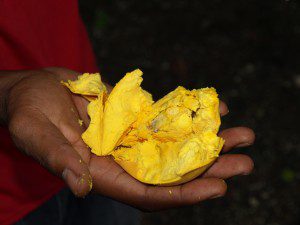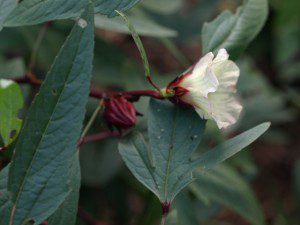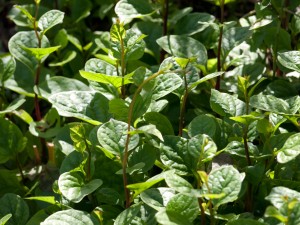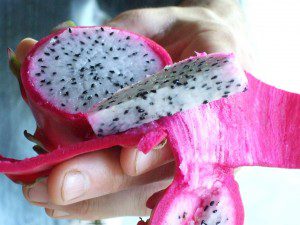Looks like the exotic fruit challenge that was posted last week offered much more of a test than the previous garden riddle that many found a lot easier to solve.
I have to give James credit for making short work of it and coming up with the correct identity for all of the strange and exotic fruits that were presented. I didn’t moderate his comment until today but he responded on Saturday and was the first and only person to get them all right.
James admitted to taking advantage of the clues offered in the November issue of the Gardening Secrets Newsletter and Wikipedia as resources but I think that being an avid sunny California gardener may have helped as well. Read on for alternate photos and additional details on the plants that were included in the tropical fruit identification challenge.
Eggfruit a Surprising and Unusual Discovery in the Tropics
 First up is the very unusual and uncommon Eggfruit. This was a new one in my book and I was a little hesitant to try it out because I wasn’t sure what to expect from these odd exotic fruits with a strange and somewhat pasty texture.
First up is the very unusual and uncommon Eggfruit. This was a new one in my book and I was a little hesitant to try it out because I wasn’t sure what to expect from these odd exotic fruits with a strange and somewhat pasty texture.
But I have to admit that I found it rather tasty with a rich, sweet flavor that is difficult to compare to any other fruit. Eggfruits grow larger than softballs and the bright yellow fruits offer a nice contrast against the dark green and shiny leaves.
At first I couldn’t imagine what this tree or its exotic fruit had in common with its namesake, but later realized that the fruit does have somewhat the look and texture of a cooked egg yolk. A little research turned up lots of interesting recipes for preparing eggfruits along with references of it being referred to as a “wonder fruit.”
The Uncommon and Very Cool Caribbean Style Sorrel
 Ida was right when she commented on the second plant which is Sorrel and is used in the Caribbean to make a delicious fruit flavored beverage, herbal teas, and syrups. The leaves can also added to leafy green salads for extra nutrients and a bit of sweet-tart flavor.
Ida was right when she commented on the second plant which is Sorrel and is used in the Caribbean to make a delicious fruit flavored beverage, herbal teas, and syrups. The leaves can also added to leafy green salads for extra nutrients and a bit of sweet-tart flavor.
Not to be confused with the Common Sorrel that is often found growing wild stateside, I believe this sorrel is the same plant known as Red Roselle. Sorrel requires warm temps and a long growing season to mature. The bright red calyxes resemble flowers but are actually the fleshy seed pods used in drinks and to prepare delicious sorrel syrup.
This is a very attractive plant with bushy growth that reach over five feet in height. I think it’s appealing enough that I will attempt to get a few seeds off to an early start and see if I can coax it to maturity in my northern climate.
Malabar Spinach the Heat Tolerant Warm Climate Alternative
 The next plant isn’t quite as tropical as it may appear; Malabar Spinach can adapt to a temperate region garden and I’m planning to plant some in my backyard next season. This is a great substitute for spinach if the temps in your growing region are too high to cultivate the regular spinach varieties.
The next plant isn’t quite as tropical as it may appear; Malabar Spinach can adapt to a temperate region garden and I’m planning to plant some in my backyard next season. This is a great substitute for spinach if the temps in your growing region are too high to cultivate the regular spinach varieties.
Malabar Spinach has a vining habit that will climb a trellis and produce loads of thick, crisp, leaves for salads. You can cut back and harvest this plant to the ground and it will quickly sprout back to produce multiple crops.
As Ida commented, the leaves do have a slimy consistency when eating but don’t let that put you off, we’re not talking okra level slime, just a bit of gel like texture when the leaves are chewed that I found to be very pleasant with no lingering aftertaste. This definitely makes a great addition in combination with other salad greens!
Dragon Fruit a Rare Find on the Island of St. Croix
 Next up are curious exotic fruits with reddish-purple skin, white flesh, and hundreds of tiny black seeds. Dragonfruit is rare and isn’t cultivated as far as I’m aware in St. Croix, but it does grow wild in mountainous regions of the island.
Next up are curious exotic fruits with reddish-purple skin, white flesh, and hundreds of tiny black seeds. Dragonfruit is rare and isn’t cultivated as far as I’m aware in St. Croix, but it does grow wild in mountainous regions of the island.
I was surprised to hear James mention that Dragon Fruit is offered in Southern California markets. In St. Croix it is a specialty fruit that is foraged from wild groves and sold for a tidy profit around town by those willing to seek them out and harvest them from typically remote areas.
Dragon Fruit is exotic looking and the flesh is incredibly striking but it doesn’t come close to the top of my list of favorite tasting tropical fruits. I’d take a fresh mango, sour sop, or papaya over the dragon fruit any day. Maybe I shouldn’t judge from one try, and it was good, but I think its popularity may have more to do with its rarity or reputed health benefits more so than its taste.
The next entry will wrap up this run down of unusual tropical fruits and share more photos and additional details about breadfruit, bananas, passionfruit, papayas, and edible loofahs.



8 Responses
Kenny, Sorrel can be grown here in Alabama. I live just outside of Huntsville, and I have a friend who plants it every year. He plants the seeds in late spring, and they are ready for reaping around late October, early November. He’s given me some seeds, and I’m going to try it this year.
In an earlier post, when you showed beautiful pictures from St. Croix, I asked you if you had come across a’ green’, similar to Collards, called Long Foot Cabbage. It’s grown in the W.Indies by cuttings, but I’ve not come across it here, unless it goes under another name. Do you know it? It’s one of my favorites, and I’d love to plant it, if possible.
Kenny, Sorrel can be grown here in Alabama. I live just outside of Huntsville, and I have a friend who plants it every year. He plants the seeds in late spring, and they are ready for reaping around late October, early November. He’s given me some seeds, and I’m going to try it this year.
In an earlier post, when you showed beautiful pictures from St. Croix, I asked you if you had come across a’ green’, similar to Collards, called Long Foot Cabbage. It’s grown in the W.Indies by cuttings, but I’ve not come across it here, unless it goes under another name. Do you know it? It’s one of my favorites, and I’d love to plant it, if possible.
Malabar spinach grows extremely well in the North Carolina summer. The seeds didn’t germinate until late spring, and the next thing I noticed it was all over the place. It tastes great raw or cooked and you can cut a six foot vine to bring indoors to prepare. I’ve read that it roots extremely easily from cuttings, but the weather had cooled by the time I learned this.
I have found dragonfruit in Philadelphia in the summertime. I love its flavor! Perhaps you didn’t get a good one? I first tried it in Taiwan, and then was very excited when I saw it in an Asian market near home.
Malabar spinach grows extremely well in the North Carolina summer. The seeds didn’t germinate until late spring, and the next thing I noticed it was all over the place. It tastes great raw or cooked and you can cut a six foot vine to bring indoors to prepare. I’ve read that it roots extremely easily from cuttings, but the weather had cooled by the time I learned this.
I have found dragonfruit in Philadelphia in the summertime. I love its flavor! Perhaps you didn’t get a good one? I first tried it in Taiwan, and then was very excited when I saw it in an Asian market near home.
FRUIT WAR! me nd my friend are having a fruit war need more fruits! ran outta ideas!!
I am teaching english in Chongqing on Mainland China here, and Dragon Fruit is a very common fruit here.